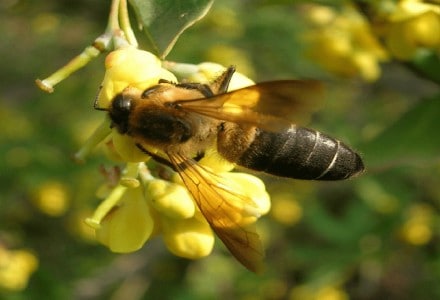
Himalayan Honey Bee Facts
- The comparatively enormous, and thankfully primarily docile, Himalayan Honey Bee easily ranks as the largest known type of honey bee. This highly remarkable invertebrate also produces a most unusual variety of honey, with unique properties.
- This uniqueness occurs partly due to various factors of its most unusual habitat range. The fascinating insect actually makes three different types of honey. Each derives from different plants visited during different periods of the year.
- In the Autumn, the honey typically comes from materials from various locations. During the Summer, it originates from lower and mid-range altitudes. In the Spring, though, the remarkable bee produces it from plants found at extreme altitudes.
- The honey from high altitudes remains quite unique, and often appears sharply red in color to the eye. Due to a unique combination of factors, it also possesses powerful relaxing qualities and actually has intoxicating effects.
- For the moment, the truly magnificent Himalayan Honey Bee does not appear on the IUCN Red List of Threatened Species. Nevertheless, it must be considered to be facing severe danger, due to both habitat loss and climate change.
Related Articles
Cuckoo Bee Cape Honey Bee Sweat Bee
Photographer: L. Shyamal
CC License: https://bit.ly/3xlSlQ7
Himalayan Honey Bee Physical Description
As the largest known variety of honey bee, one particular characteristic of the remarkable Himalayan Honey Bee stands out. That, of course, is the physical size of this fabulous arthropod. Individuals attain an astonishing average length measuring roughly 1.2 in (3 cm).
In other respects though, its physical appearance remains very much like that of related species. In fact, only the disparity in size distinguishes it from others, in terms of appearance. The precise evolutionary reason for its enormous size remains a mystery to researchers.
The males, or drones, of the Himalayan Honey Bee have large eyes and comparatively short abdomens. It also possesses no stinger. The coloring often varies slightly between individuals. This mainly includes combinations of brown, black, and dark yellow.
- Kingdom: Animalia
- Phylum: Euarthropoda
- Class: Insecta
- Order: Hymenoptera
- Family: Apidae
- Genus: Apis
- Species: A. dorsata
Photographer: L. Shyamal
CC License: https://bit.ly/1p2b8Ke
Himalayan Honey Bee Distribution, Habitat, and Ecology
The very name of the Himalayan Honey Bee provides all the evidence one needs of the natural habitat range of this impressive insect. As the common name implies, this incredible invertebrate appears to have evolved to a very specific section of Asia.
More specifically, however, this region partly consists of what now constitutes the countries of Nepal and India, within the Himalayan Mountains. The rest of its range, however, covers parts of Bhutan, and the Yunnan province in China.
Even within that range, though, this amazing insect appears in only certain very specific areas. That holds true due to the very nature of its construction practices. In fact, the awesome bee nests only at extremely high and specific altitudes.
Typically, these precise heights measure around 9,800 ft (3,000 m) above sea level. As if that weren’t awesome enough, it also builds its nests as extremely large. Remarkably, these most often appear under overhangs on the southwest sides of vertical cliffs.
The sincerely fascinating Himalayan Honey Bee actually forages at altitudes of as much as an incredible 13,500 ft (4,100 m). A single one of its massive nests sometimes contains as much as 130 lb (60 kg) of honey. That makes a lot of goodness in just one nest.
Species Sharing Its Range
Chinese Lantern Indian Bullfrog Bharal
Check out our other articles on 4 Remarkably Unique Rabbits, Galapagos Penguin, Gorges du Tarn, San Diego Thornmint, Dall’s Porpoise, Lange’s Metalmark Butterfly, Draco Volans

